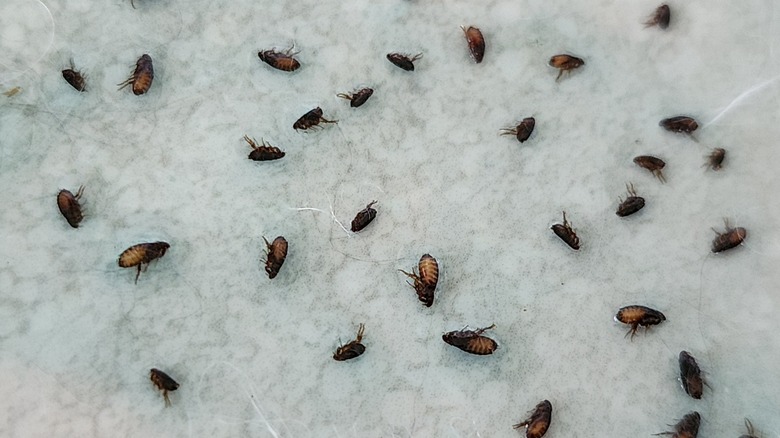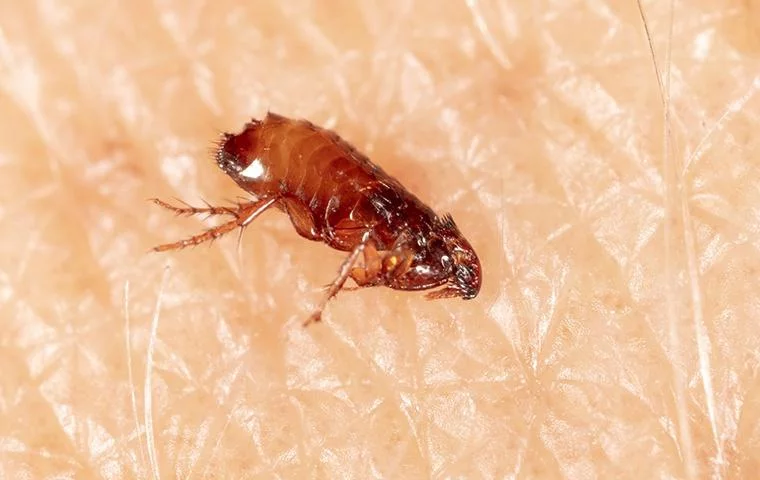Flea Treatments in Florida
Exterminator Services for Clearwater, Clearwater Beach, Largo, and Belleair Beach
Florida’s subtropical climate, prized for its gentle winters and sun-filled days, is equally welcoming to a variety of pests, including fleas. These tiny, jumping parasites feed on the blood of warm-blooded hosts—particularly pets—and can irritate both animals and people if they invade homes or business properties. For pet owners and property managers in Clearwater, as well as nearby areas like Clearwater Beach, Largo, and Belleair Beach, fleas pose a persistent threat. Their bites cause itchy welts and, in some instances, possible illness or allergies. This service page explores how fleas flourish in Florida’s conditions, signs pointing to an infestation, and how professional flea treatments from an experienced flea exterminator help restore a pest-free environment. By acting rapidly to quell flea populations, you defend your property, maintain occupant comfort, and protect pets from ongoing misery.
Why Fleas Thrive in Florida
- Consistently Warm Temperatures
In cooler states, harsh winters naturally reduce flea numbers by killing many during sub-freezing stretches. Florida’s winter rarely remains frigid for extended periods, granting fleas continued activity through most of the year. Heated or air-conditioned interiors also preserve moderate temperatures indoors, letting fleas breed and feed uninterrupted if conditions remain suitable. - High Humidity and Rainfall
Fleas need moisture, especially in their larval and pupal stages. Florida’s humidity, accentuated by frequent rains, fosters damp soil, shady lawn corners, and leaf piles that create ideal microhabitats for flea development. By the time fleas reach adulthood, they merely need a warm-blooded host—pets or humans—to begin feeding. - Minimal Seasonal Downtime
In areas experiencing lengthy cold periods, flea populations face extended dormancy or substantial die-offs. In contrast, southwestern Florida’s mild climate imposes minimal slowdowns. An influx of fleas can thus arise at almost any time if an animal or piece of furniture unknowingly carries fleas indoors. - Frequent Movement and Tourism
Regions like Clearwater and Clearwater Beach see a high volume of visitors. If even one guest’s pet or a piece of luggage arrives harboring fleas, they can quickly hop off and find new hosts in a warm property. In multi-unit buildings or busy lodging areas, fleas easily spread from one unit to adjacent ones via hallways or shared yard spaces. - Wildlife and Pet Presence
Feral cats, raccoons, or opossums roaming yards can drop fleas onto lawns or around outbuildings. Pets exploring yards or dog parks risk picking up adult fleas searching for a meal, bringing them back indoors. Any minor gap in household cleanliness or pet care can allow fleas to root themselves in carpets, furniture, or cracks along floors.

Signs of a Flea Infestation
- Pet Scratching or Grooming Intensely
One of the earliest clues is a dog or cat persistently biting at their fur—often near the tail base, belly, or hind legs. Pets with flea allergies may show patches of missing hair, sores, or reddened skin from excessive licking or scratching. Running a flea comb through the fur might reveal adult fleas or black specks (flea dirt). - Fleas Jumping on Floors or Clothing
Adult fleas are tiny, brownish-red, and spring away when disturbed. You might see them on carpets, around pet bedding, or leaping onto socks if you walk through an infested area. Spotting even one or two indicates more likely hide unseen in cracks or upholstery. - Bites on Humans
Fleas prefer animals but will bite humans when necessary, often leaving small, itchy welts around ankles or lower legs. Sometimes arranged in lines or clusters, these bites might be mistaken for mosquito bites at first. If you notice repeated bites after time spent indoors, fleas may be established nearby. - Flea Dirt
Flea droppings, resembling coarse black pepper, often gather on pet bedding, rugs, or under furniture. Sprinkling these specks onto a damp white cloth can make them turn reddish-brown, signifying digested blood. - Unexplained Pet Restlessness
If a previously calm pet avoids certain yard sections or refuses to rest on usual bedding, they might sense fleas lurking. Investigating those areas could uncover fleas, eggs, or larvae hidden in damp corners or thick vegetation.
Why Prompt Flea Treatments Matter
- Rapid Reproduction
A single female flea can lay numerous eggs daily, dropping them anywhere the host travels—carpets, sofa cushions, or yard soil. Within a matter of weeks, eggs hatch into larvae, which pupate and emerge as adult fleas. Neglecting a small outbreak provides time for exponential population growth. - Health and Comfort
Flea bites irritate humans and animals alike, causing scratching, potential secondary infections, or allergic dermatitis in pets. Some fleas carry parasites, like tapeworms, that can infect animals. Eliminating fleas ensures everyone’s comfort and avoids medical expenses. - Potential Transmission to Neighbors
In multi-unit complexes or closely spaced residences, fleas can leap from yard to yard or spread via shared hallways if an infestation remains unchecked. Early containment spares communities from larger-scale flea problems. - Daily Stress
Living amidst fleas disrupts routines, prompting repeated vacuuming, furniture checks, or occupant anxiety about bites. Thorough extermination resolves the nuisance, enabling families to enjoy living spaces and letting pets roam indoors without incessant itching.

Why Professional Flea Treatments Are Essential
- In-Depth Property Inspection
A professional flea exterminator evaluates both the indoor and outdoor environment, identifying flea hotspots—like pet bedding, yard edges, or carpets in low-traffic rooms. Different species or life cycle stages might appear in shady yard corners versus upholstered chairs, guiding the exterminator’s plan of attack. - Integrated Techniques
Experts tackle fleas by applying insect growth regulators indoors, yard treatments for eggs or larvae, and occupant cooperation on pet treatments. By blending chemical and non-chemical methods—like vacuuming or steam cleaning—flea life stages (eggs, larvae, pupae, and adults) face lethal conditions, halting reproduction. - Safe, Targeted Application
Over-the-counter insecticides can be misapplied, risking occupant exposure or partial success. Professionals precisely direct solutions at corners, cracks, or yard edges fleas frequent. This measured approach maximizes coverage on fleas while protecting children and pets from excessive chemicals. - Breaking the Flea Lifecycle
Flea pupae can remain dormant for weeks. Scheduling re-checks or occupant monitoring ensures newly hatched fleas quickly encounter insect growth regulators or treatments. Without this approach, an overlooked pocket of pupae can spark a fresh outbreak after initial adult fleas die. - Collaboration with Pet Care
While exterminators address the environment, occupant vigilance—like using veterinarian-approved flea preventatives or medicated pet shampoos—remains integral. Flea solutions alone fail if pets remain untreated and reintroduce fleas from yard walks or dog parks.
Effective Tactics Used by a Flea Exterminator
- Vacuuming and Cleaning
Vacuuming picks up adult fleas, eggs, and larvae from carpets, upholstery, or pet bedding. Disposing of vacuum contents in sealed plastic outside prevents fleas from returning. Some exterminators might also recommend steam cleaning for heavily infested carpets or cushions. - Insect Growth Regulators (IGRs)
Sprays or foggers containing IGRs impede flea development, stopping larvae or pupae from reaching biting adulthood. Targeted application in cracks, along baseboards, or in shady yard nooks reduces the next generation of fleas. - Outdoor Treatments
Many fleas hop onto pets in yards, then ride indoors. Treating yard edges, under decks, or near fences with larvicides kills eggs or larvae left behind by visiting wildlife. Regular yard maintenance—like short grass, removing leaf piles—ensures fewer damp hideaways for fleas. - Pet Involvement
Owners typically treat their animals separately using topical medications, oral chewables, or flea collars recommended by veterinarians. Grooming pets frequently, washing bedding, and quarantining new animals until they’re cleared of fleas helps maintain a flea-free environment. - Follow-Up Examinations
Because eggs might hatch after initial treatments, scheduling a second check or occupant-based monitoring helps confirm success. If occupant sightings persist, additional spot or yard treatments finalize elimination.
- Vacuuming and Cleaning

Service Areas: Clearwater, Clearwater Beach, Largo, and Belleair Beach
Clearwater: Known for bustling tourism, frequent occupant movement, and scenic coastal life. Fleas can arrive via pets or from secondhand furniture in newly rented apartments, emphasizing occupant vigilance. Checking yards and pet bedding thoroughly avoids widespread infestations.
Clearwater Beach: A coastal destination with ample short-term rentals or hotels, producing constant traveler turnover. Fleas introduced by a guest’s pet can quickly jump between rooms if no one intervenes. Comprehensive solutions incorporate occupant education—storing luggage properly, vacuuming after guests check out, or yard treatments as needed.
Largo: Blending suburban living with older properties, Largo sees potential fleas from wildlife crossing yards or multi-unit dwellings. Regular occupant checks in corners or behind furniture hamper expansions. Timely yard maintenance plus occupant diligence fosters a less flea-friendly environment.
Belleair Beach: A quieter waterfront community with a mix of permanent and seasonal homes. Fleas might settle if year-round pests like feral cats or raccoons roam unmonitored yards. Thorough occupant collaboration and ongoing property inspections mitigate infiltration and breeding spots.
Why Our Flea Treatments Excel
- Florida-Specific Strategies
Because fleas breed year-round, we incorporate occupant cooperation—like vacuuming and washing pet bedding daily—to reduce eggs or larvae. By applying insect growth regulators indoors and yard solutions outside, we cut off fleas in every stage, from egg to adult. - Targeted, Minimal Disruption
We apply insecticides carefully in hotspots—like corners, furniture seams, or yard edges—rather than spraying large areas. This approach protects children or pets while cornering fleas. A short occupant re-entry wait might be necessary if treatments must fully dry, but otherwise daily routines continue smoothly. - Pet Collaboration
We emphasize occupant-pet synergy, as fleas commonly feed on dogs or cats. By urging owners to place their pets on veterinarian-endorsed flea preventatives, we ensure newly hatched fleas that attempt to latch on animals soon die, preventing reintroduction. - Post-Treatment Confirmation
Because pupae can stay dormant, scheduling re-checks ensures that newly emerged fleas meet lethal conditions. If occupant sightings persist or fresh bites occur, we adapt or intensify treatments before fleas can re-establish.
Next Steps
Noticing your dog or cat scratching constantly? Seeing small, jumping insects on carpets or near doorways? Contact us to learn more or schedule your service. Our flea exterminator plan targets fleas at each life stage—eggs, larvae, pupae, and adults—covering every corner of your home or property in Clearwater, Clearwater Beach, Largo, and Belleair Beach. Prompt action spares you and your pets further bites, potential diseases, and the nuisance of repeated deep-cleaning attempts.
Preventing Future Flea Recurrences
Once fleas are eliminated, regular measures keep them from gaining a new foothold:
- Vacuuming: Floors, furniture, pet bedding, and tight corners each week. Seal vacuum contents in plastic and discard outdoors immediately.
- Wash Pet Bedding Frequently: High-heat washing and drying kills fleas or eggs lodged in blankets or cushions.
- Use Pet Preventatives: Dogs or cats typically benefit from monthly topical or oral flea medications. Collars can also help, but consult a veterinarian for best results.
- Trim Lawns and Remove Yard Debris: Short grass, cleared leaf piles, and minimal shading hamper flea larvae survival outside. Avoid feeding stray animals near property lines if possible, as they might drop fleas.
- Inspect After Travel or Boarding: If pets visit kennels or dog parks, examine them upon returning, especially near the ears, belly, or tail base, where fleas often hide.
By merging occupant maintenance with a strong professional solution, southwestern Florida property owners can stay on top of fleas. Even if mild winters, humidity, and constant foot traffic favor these parasites, occupant vigilance plus robust environmental control ensures your pets and household remain free from ongoing flea ordeals.
